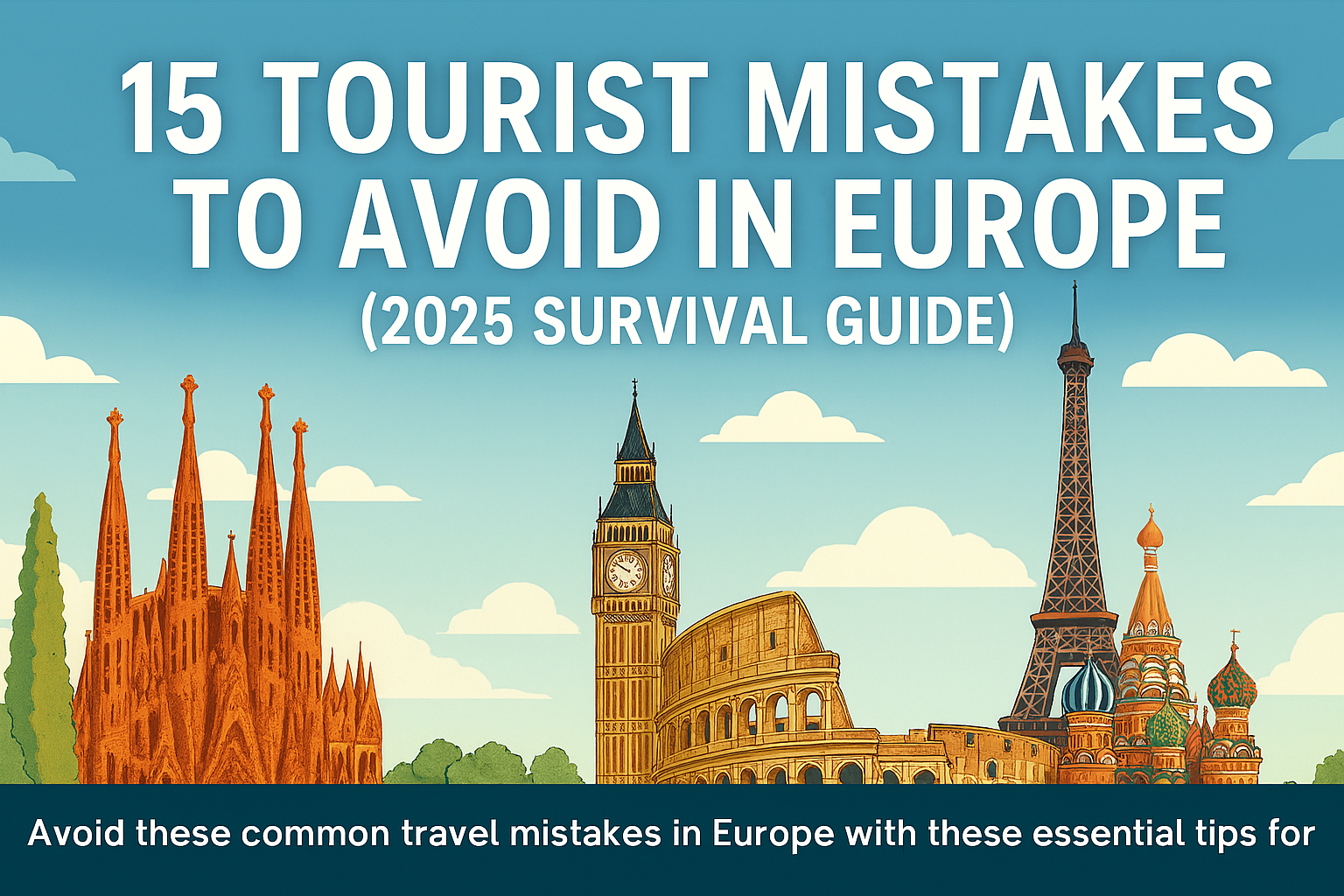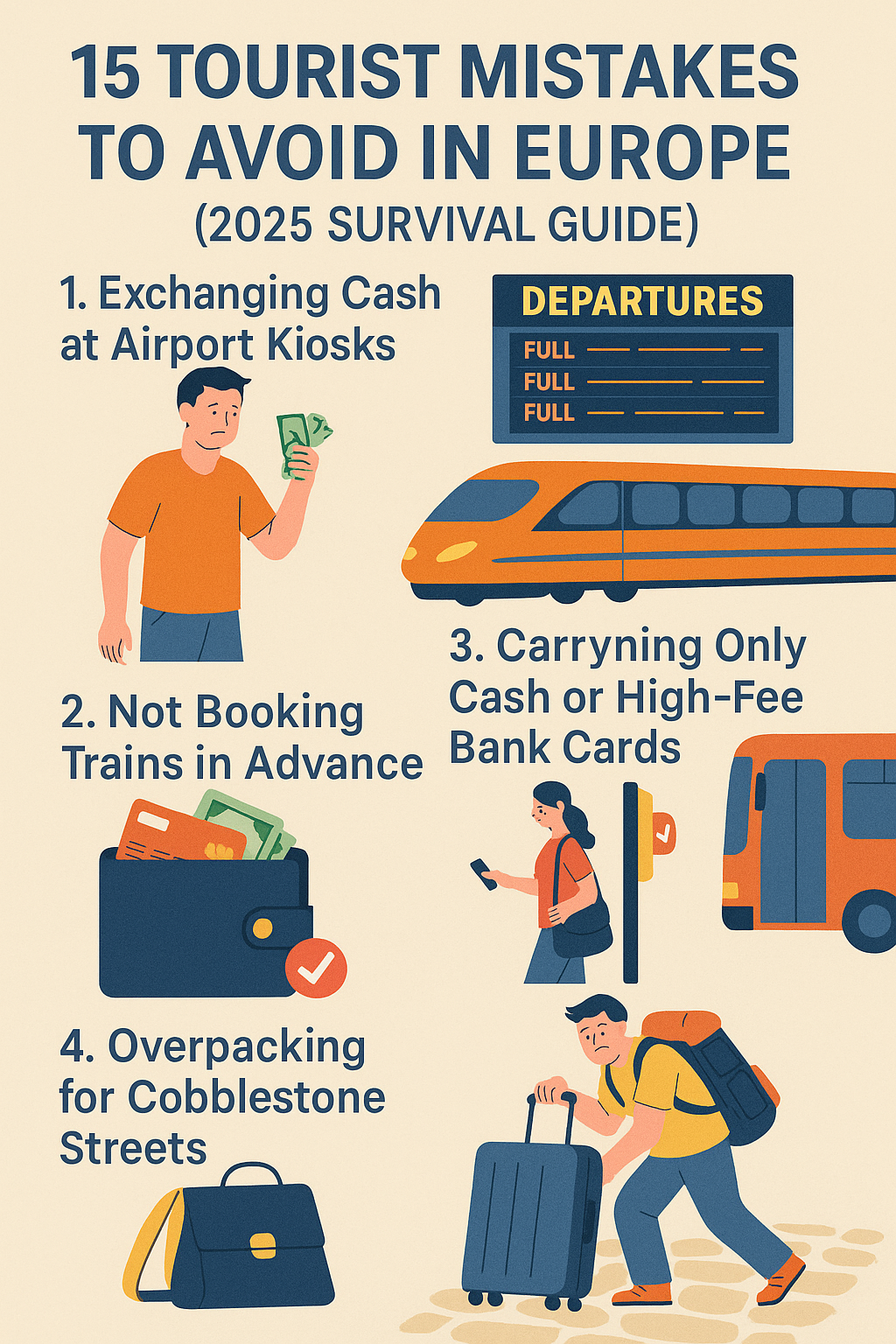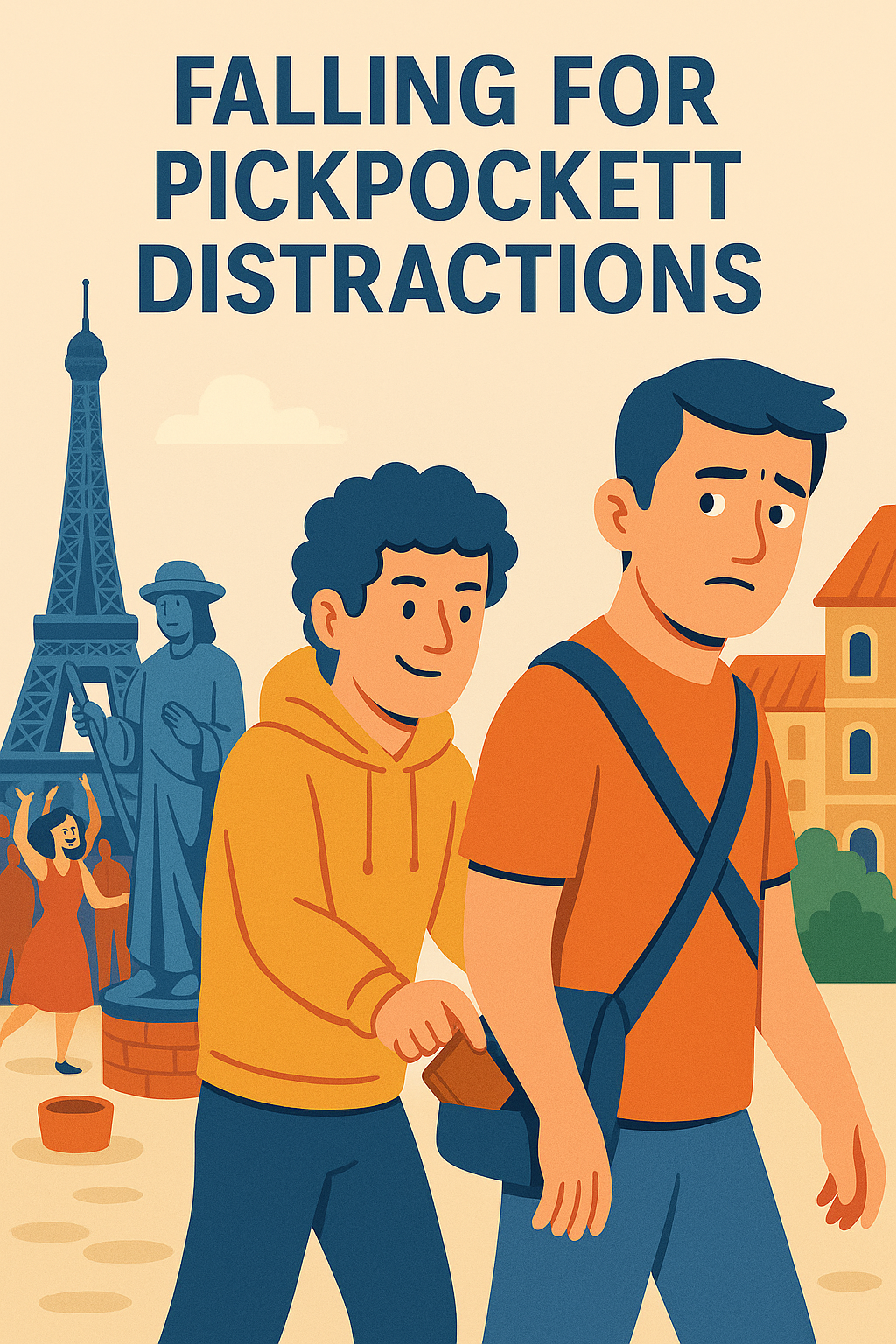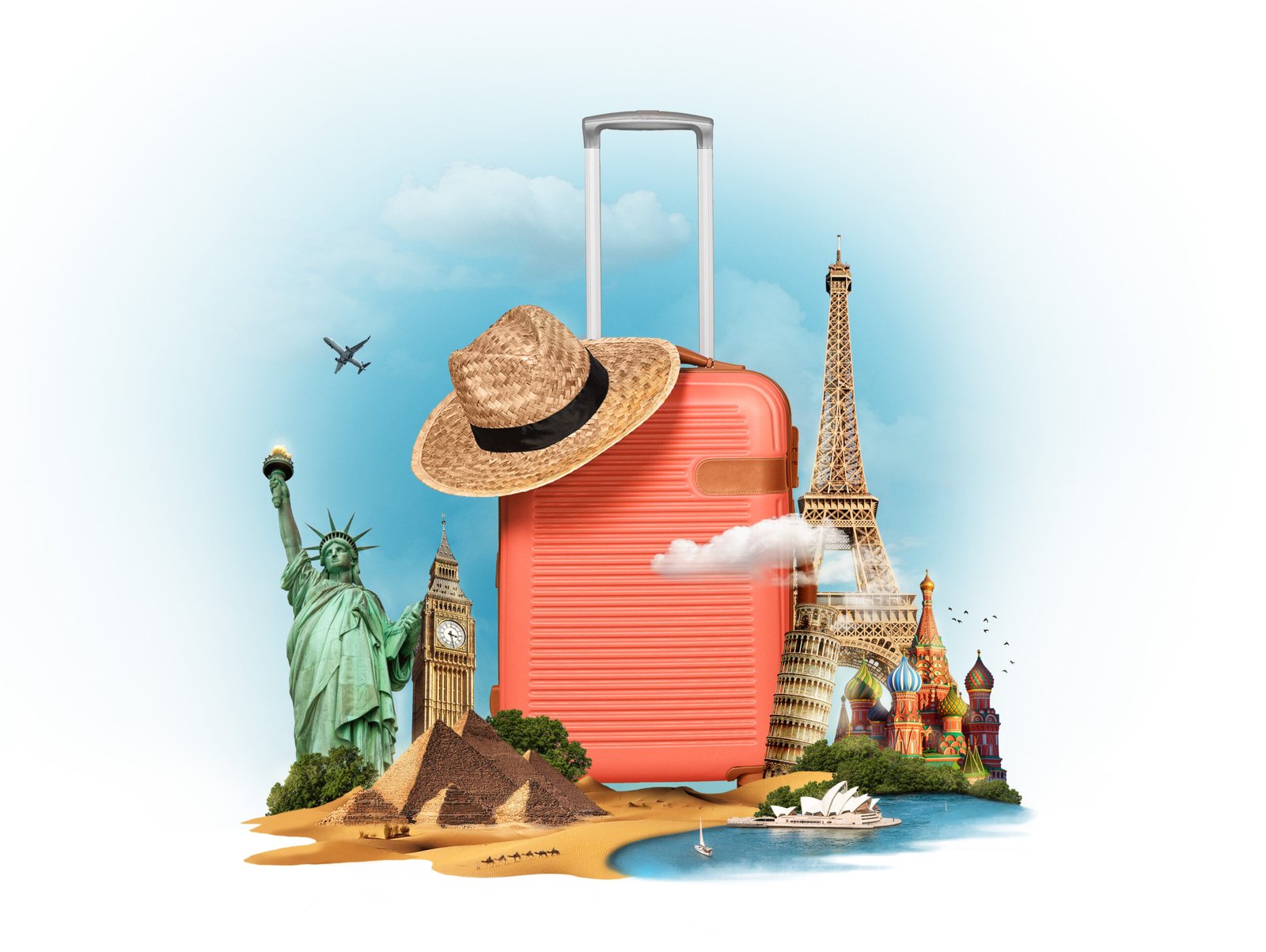Tourist mistakes in Europe:
Why Europe is amazing yet full of easy mistakes
Europe is a continent that captivates travelers with its rich history, world-famous landmarks, and vibrant cultures. From the romantic streets of Paris to the hidden gems of Eastern Europe, there’s no shortage of breathtaking experiences waiting for you.
But while Europe promises unforgettable adventures, it also comes with its fair share of challenges – especially for first-time visitors. Simple mistakes can quickly turn a dream trip into a stressful, expensive, or even dangerous experience.
That’s why I’ve created this 2025 Survival Guide, highlighting 15 of the most common mistakes tourists make in Europe and how you can avoid them. These tips will save you money, keep you safe, and ensure you enjoy your travels to the fullest.
Whether you’re planning a quick getaway or a month-long backpacking trip, knowing what not to do is just as important as knowing what to see. This guide on tourist mistakes in Europe will prepare you for a stress-free adventure.
Read on to discover the mistakes you don’t want to make – and travel Europe like a pro in 2025.
Disclosure: This post contains affiliate links. If you purchase through them, I may earn a commission at no extra cost to you — thank you for supporting Frugal Nomad Life!

1. Exchanging Cash at Airport Kiosks
One of the quickest ways to lose money in Europe is by exchanging cash at airport currency kiosks. These counters often advertise “no commission” or “best rates,” but in reality, they offer some of the worst exchange rates with hidden fees built into the transaction. Many travelers, eager to get local currency upon arrival, end up losing 5–15% of their money instantly, leaving them with less to spend on food, experiences, and transport. Over the course of your trip, these small losses can add up to a significant chunk of your budget.
💡 Better alternative:
Avoid airport kiosks altogether by using a multi-currency travel card like Revolut or Wise. These cards let you pay directly in local currencies at the real exchange rate, with minimal or no conversion fees. They’re widely accepted across Europe and far safer than carrying large amounts of cash.
✅ Pro Tip: Order your Revolut or Wise card before your trip, top it up via their app, and enjoy stress-free spending from day one.
2. Not Booking Trains in Advance
Train travel in Europe is iconic. There’s something magical about gliding through the French countryside on a high-speed TGV or watching rolling Tuscan hills from an Italian Frecciarossa. But many tourists make the costly mistake of buying tickets at the station last minute, thinking it’s as casual as hopping on a local bus. What they find instead are sky-high prices, limited seat availability, or fully booked trains, especially during peak travel seasons or weekends. High-speed train tickets often work like airline fares – prices increase as departure approaches, sometimes doubling or tripling the cost.
Not booking in advance can also disrupt your itinerary if seats sell out entirely, forcing you onto slower regional trains or awkward travel times. This is particularly common on popular routes like Paris to Amsterdam, Rome to Florence, or Barcelona to Madrid, where demand is high among both locals and tourists.
💡 Better alternative:
Always book your tickets in advance via platforms like Omio or Rail Europe. These services let you compare prices across operators, reserve your seat early, and often secure discounted fares up to 50% cheaper than day-of prices.
✅ Pro Tip: Regional trains usually have fixed prices, but high-speed and international routes reward early planners with huge savings.
3. Carrying Only Cash or High-Fee Bank Cards
Many travelers still think Europe is a “cash-only” destination. While cash is handy in small markets, relying on it entirely is risky and expensive. Using traditional debit or credit cards can also lead to high foreign transaction fees.
💡 Better alternative:
Get a Revolut or Wise multi-currency card to withdraw cash affordably and pay like a local without extra fees.
✅ Affiliate Tip: Sign up for Revolut here to avoid hidden bank charges and get your card delivered before departure.
4. Not Validating Public Transport Tickets
In many European cities, simply buying a ticket isn’t enough – you also need to validate it before boarding trains, buses, or trams. This small but crucial step stamps your ticket with a time and date, proving it’s in use. Tourists unfamiliar with this system often hop on thinking their purchased ticket alone is sufficient, only to be met with hefty fines from ticket inspectors who make no exceptions for “I didn’t know.” These fines can range from €30 to over €100 depending on the city, and payment is usually demanded on the spot.
trams. This small but crucial step stamps your ticket with a time and date, proving it’s in use. Tourists unfamiliar with this system often hop on thinking their purchased ticket alone is sufficient, only to be met with hefty fines from ticket inspectors who make no exceptions for “I didn’t know.” These fines can range from €30 to over €100 depending on the city, and payment is usually demanded on the spot.
💡 Why it matters:
Ticket validation prevents fare evasion, which is why enforcement is strict. For example, in Italy, regional train tickets must be validated at small yellow or green machines on the platform before boarding. In Germany, U-Bahn and S-Bahn systems often use a proof-of-payment system where you validate tickets at platform machines, with undercover inspectors checking randomly.
💡 Better alternative:
Always validate your ticket immediately after purchase if required. Look for small validation machines near platforms or at bus entrances. If you’re unsure, watch what locals do or ask a station staff member.
✅ Example: In both Italy and Germany, unvalidated tickets are considered completely invalid, even if you purchased them legally. Don’t risk ruining your trip over a simple overlooked step.
5. Overpacking for Cobblestone Streets
Rolling a massive suitcase across Europe’s beautiful but bumpy cobblestone streets is a rookie mistake many travelers regret within their first hour of arrival. These charming old streets may look picture-perfect, but they are a nightmare for flimsy suitcase wheels. Dragging heavy luggage over uneven stones is noisy, exhausting, and can even damage your suitcase beyond repair.
The struggle doesn’t end there. Many train stations across Europe have no elevators or escalators, meaning you’ll be lifting that heavy suitcase up multiple flights of stairs. Similarly, old hotels and Airbnb apartments in historic buildings often lack lifts, forcing you to haul your luggage up narrow, steep staircases after a long travel day. One of the most overlooked tourist mistakes in Europe is packing too much for cobblestone streets. It quickly turns your trip into a full-body workout you never planned for, draining your energy before the sightseeing even begins.
💡 Better alternative:
Pack light with a carry-on backpack or a sturdy wheeled suitcase designed for uneven surfaces. Focus on versatile, easy-to-layer clothing that works across climates and occasions.
✅ Pro Tip: If you plan to explore multiple cities by train, choose a lightweight backpack under 40L. It will fit easily into train luggage racks, save your back on stairs, and keep your travels stress-free and agile.
6. Booking Hotels Right Next to Major Tourist Attractions
It might sound convenient to stay a stone’s throw from the Eiffel Tower or the Colosseum — but these hotels often charge inflated rates for tiny rooms. Plus, they’re usually surrounded by overpriced restaurants and tourist traps.
💡 Better alternative:
Look for accommodation just a few metro stops away from the main sights. Neighborhoods slightly outside the tourist core often feel more authentic, are quieter at night, and cost far less.
✅ Pro Tip: Use Booking.com or Hostelworld to compare areas and find stays with great reviews in local neighborhoods.
7. Falling for Pickpocket Distractions – A Common Tourist Mistake in Europe
Pickpockets thrive in Europe’s busiest tourist spots, where crowds make it easy to blend in and escape unnoticed. Places like  Rome’s Trevi Fountain, Barcelona’s Las Ramblas, Paris’ metro lines, and Prague’s Old Town Square are notorious hotspots. They often work in groups and use clever distraction techniques to catch you off guard. Common tactics include someone “accidentally” bumping into you, spilling a drink, or staging an argument nearby to divert your attention while their accomplice slips your wallet from your bag or pocket.
Rome’s Trevi Fountain, Barcelona’s Las Ramblas, Paris’ metro lines, and Prague’s Old Town Square are notorious hotspots. They often work in groups and use clever distraction techniques to catch you off guard. Common tactics include someone “accidentally” bumping into you, spilling a drink, or staging an argument nearby to divert your attention while their accomplice slips your wallet from your bag or pocket.
Another popular scam is the fake petition trick, where someone approaches you with a clipboard asking for your signature on a fake cause. While you’re signing, an accomplice may be picking your pocket. Street performers can also attract crowds, making it easy for pickpockets to move between tourists undetected.
💡 Better alternative: Always stay aware of your surroundings, especially in crowded areas. Wear a money belt under your clothes or use an anti-theft backpack with hidden zippers to protect your valuables. Avoid keeping wallets or phones in back pockets or easily accessible outer pockets. If someone approaches you with a petition or aggressive sales tactic, keep walking and maintain your personal space. For official travel safety tips, visit the EU’s Travel Safety Advice.
✅ Linked Tip: For more on this, check out my Top 10 Travel Scams to Avoid in Europe (2025) to stay two steps ahead.
8. Using Expensive Roaming Instead of a Local SIM or eSIM
Many travelers arrive in Europe and keep their home SIM card active, racking up huge roaming charges for calls and data. By the time you get your bill, your travel budget could be blown.
💡 Better alternative:
Buy a local SIM card at your destination or order an eSIM before departure. You’ll get plenty of data for maps, bookings, and local calls — at a fraction of roaming prices.
✅ Pro Tip: Some travel-friendly banks like Revolut now offer eSIM plans for travelers. Double up on savings with one tool!
✅ Linked Tip: For more on this, check out my Top 10 Travel Scams to Avoid in Europe (2025) to stay two steps ahead.
9. Not Checking If a City Pass is Actually Worth It
Many tourists buy city passes thinking they’ll save money — but often, they don’t visit enough included attractions to justify the cost. Some passes only make sense if you plan to do multiple expensive museums or tours each day.
💡 Better alternative:
Compare the pass cost to individual ticket prices and see if it matches your realistic itinerary.
✅ Linked Tip: Read my Top 10 City Passes in Europe (2025 Edition) to find the best value passes for your plans.
✅ Linked Tip: Read my Top 10 City Passes in Europe (2025 Edition) to find the best value passes for your plans.
10. Dining at Restaurants with ‘Tourist Menus’
Restaurants right next to major landmarks often advertise “Tourist Menus” in English — overpriced dishes with mediocre quality. Locals rarely eat there. You’re paying for the view, not the meal.
💡 Better alternative:
Wander a few blocks away into side streets and look for places where locals actually eat. Menus in the local language, a full dining room, and handwritten chalkboards are good signs.
✅ Pro Tip: If you’re on a tight budget, lunch menus (Menu del Dia in Spain, Pranzo in Italy) offer the best value.
11. Skipping Travel Insurance
Many travelers think travel insurance is an unnecessary expense – until they face a cancelled flight, lost luggage, or sudden medical emergency abroad. European healthcare for non-EU visitors can be shockingly expensive, and emergencies can ruin your savings in an instant.
💡 Better alternative:
Always get affordable travel insurance that covers medical, trip interruption, and lost belongings.
✅ Affiliate Tip: I use SafetyWing for flexible, budget-friendly coverage that works across Europe and beyond.
12. Not Researching Cultural Etiquette
From tipping customs to dress codes, Europe’s cultural norms vary widely between countries and even regions. Not knowing them can lead to awkward situations, embarrassment, or coming across as disrespectful – something no traveler wants. Simple gestures that are acceptable in one country may be frowned upon in another. For example, tipping in France and Italy is often already included in your bill as a service charge, so leaving extra is not expected. In contrast, in Germany, small tips for cafes or casual dining are appreciated and often given by rounding up the bill.
Dress codes are another key area travelers overlook. Visiting a church or cathedral in Italy, Spain, or Greece requires covering shoulders and wearing knee-length clothing as a sign of respect. Arriving in swimwear, shorts, or strappy tops may get you refused entry. Similarly, in many Spanish coastal towns, walking around shirtless or in bikinis away from the beach can result in fines, as it’s considered inappropriate.
✅ Better alternative:Do a quick etiquette check before visiting each country. Learn local tipping standards, public behavior expectations, and cultural dress norms to avoid fines and ensure you’re a respectful, welcomed visitor wherever you go.
13. Trying to See Too Many Countries in One Trip
Europe’s compactness makes it tempting to visit 5–7 countries in two weeks. But constant transits, check-ins, and currency  changes lead to exhaustion, burnout, and barely experiencing each place.
changes lead to exhaustion, burnout, and barely experiencing each place.
💡 Better alternative:
Slow down and spend more days in each city. You’ll save on transport costs, avoid fatigue, and truly immerse yourself.
✅ Pro Tip: Choose 2–3 countries max for a two-week trip to enjoy the journey, not just tick off destinations.
✅ Related Tip: If you’re planning flights between countries, read my Beginner’s Guide to Booking Cheap European Flights in 2025 to save money on intercity travel.
14. Ignoring Local Holidays or Closures
Many travelers plan trips without checking local holidays or events, only to arrive and find shops, attractions, or entire towns closed. For example, many businesses in Italy and France shut down in August for summer holidays.
💡 Better alternative:
Check public holidays and major event calendars in each country you visit to avoid surprises.
✅ Pro Tip: Sometimes traveling during festivals is great – but book accommodation early as prices skyrocket.
15. Using Unsafe Public Wi-Fi Without Protection
Free café or airport Wi-Fi might be convenient, but it’s also an easy entry point for hackers to steal your passwords, banking details, and personal data.
💡 Better alternative:
Always use a VPN (Virtual Private Network) to encrypt your connection and protect your sensitive information.
✅ Affiliate Tip: Consider NordVPN (or your preferred VPN affiliate) for fast, secure browsing while traveling.
Conclusion
That wraps up the 15 most common tourist mistakes to avoid in Europe. Traveling this diverse and historically rich continent is an incredible experience, but it comes with challenges that can catch even experienced travelers off guard. By staying informed about local customs, transport systems, and common scams, you’ll save money, avoid stressful situations, and get the absolute most out of your European adventure.
Remember, a little planning goes a long way. Whether it’s booking your train tickets in advance, packing light for those cobblestone streets, or getting the right travel card to avoid hidden fees, these simple changes can transform your trip from stressful to seamless. By avoiding these common tourist mistakes in Europe, you’ll save money and travel confidently in 2025. For more Europe travel tips, check out my Beginner’s Guide to Booking Cheap European Flights
✅ Ready to travel smarter in 2025?
-
Get your Revolut or Wise multi-currency travel card and say goodbye to poor exchange rates.
-
Grab SafetyWing travel insurance for complete peace of mind wherever you go.
-
Stay safe on public Wi-Fi with NordVPN and protect your data on the go.
Finally, share this guide with a friend who’s planning a European trip this year. Help them avoid these mistakes so they can travel confidently, spend wisely, and create memories that last a lifetime.
✨ Ready to Travel Smarter in Europe?
Avoid these common mistakes and travel confidently with the right tools:
✅ Get your Revolut or Wise card today – pay like a local and avoid hidden fees
✅ Grab SafetyWing travel insurance – stay protected wherever you go
✅ Secure your data with NordVPN – browse safely on public Wi-Fi
Plan smart, save money, and enjoy your 2025 Europe adventure to the fullest.
Disclosure: This post contains affiliate links. If you purchase through them, I may earn a commission at no extra cost to you — thank you for supporting Frugal Nomad Life!
